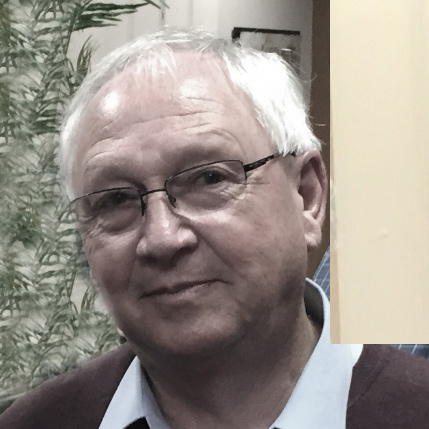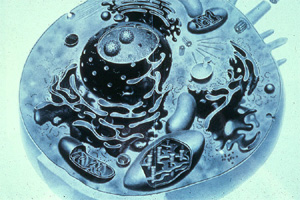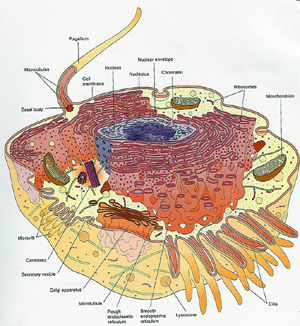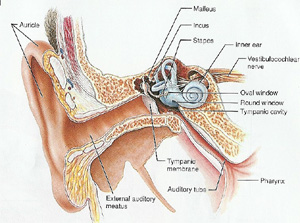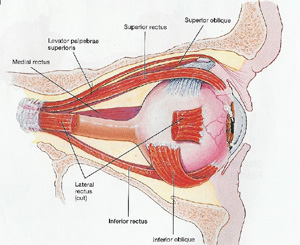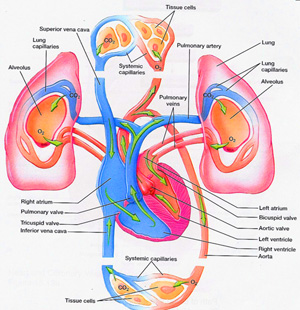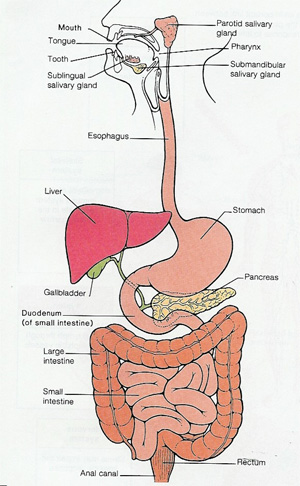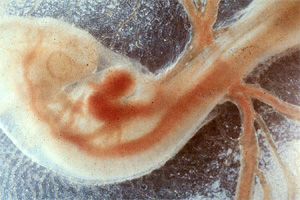Let's continue with the subject of the complexity of life. You see, as we started out by saying in our initial presentation, this is a very significant issue for everyone because somewhere along the line we need to determine why we exist—where we have come from. And I would think that every one of you, at one time or another, has thought about this. It is very important.
Why do we exist? Is it by chance or do we exist because there is a Creator? Well, for many of us it seems very obvious. One of the major arguments that people often present is: “My body is very complex,” and you have all heard this argument. Paley's argument about the watch is that a watch requires a watchmaker, doesn't it? Then what about the human body? Evolutionists say this is not necessary and so the objective of our presentation will be to look at the complexity of life. What makes us—the complexity of the cells and of the systems that make up our own body? If a watch requires a watchmaker—then what about you and me? Can it be verified that there is a Creator?
Well, with regard to the complexity of life there are two choices. The evolutionary view is that life exists because of random chance. They say all of the complexity that we see can simply be understood given matter, chance, and time.
But the opposite of that is the other worldview, which is the Creation worldview that says there has to be an intelligent Designer. And of course, the Bible says that intelligent Designer is the Creator. More specifically, as we have already quoted from Scripture, the intelligent Designer—the Creator—is Jesus Christ.
Let us examine this topic of the complexity of life. This is a very simplified diagram of a cell. And the reason I show this cell is because it means something to me. It is very important and I will tell you why.
Often people want to know what it was in your life that caused you to change. Well, there were many things in my life, but here is one thing. One day I was sitting down and I was reading from a biology textbook that I had looked at many times before. And I had been reading for an hour or so and I laid the book down, placing it on a table. For some reason I started to look around the room and on the wall before me there was a painting. Well, that painting had hung on the wall for years, but for the first time in my life when I looked at it, the thought came into my mind that “the painting was painted by an artist!” And then I looked down at the book in front of me that I had just laid down and the thought came to me, “Well, I can see the author's name on the title page—it had been written by an author!” And then I looked at the table that the book was sitting on, which was a table that I had constructed during a woodworking class in high school. When I opened the biology textbook, back to the page where I had closed it, I saw this diagram of a cell. And something came to me for the first time and that was a reality that life was very complex. And if paintings required artists, and books required authors, and tables required carpenters, what about life? That was a major step for me!
You see the cell is supposed to be the simplest unit of life, but everyone knows that a cell is not simple—it is very, very complex. And within this cell wall we see a number of structures and these structures have particular functions. And so, we look at another more sophisticated cellular diagram and we can see more of these structures. How did they come into existence? You see a cell is like a factory. How could a factory containing all of these specific structures with functions evolve? Remember, scientists admit the possibility of a protein molecule evolving to a cell is one over ten followed by fifty-six zeros.
What about the cell? I am going to read to you the definition of various cellular structures. And this is something you do not need to memorize, but I just want you to think about it as we look at these structures and we give you the definition of what they are and what they do. These definitions are from various biological textbooks, usually high school textbooks.
Membrane proteins—these molecules span the exterior cell membrane and act as a monitor for informing the cell what is outside its boundaries.
Endoplasmic reticulum—a network of channels which store and carries proteins from factory locations to other locations in the cell.
Ribosomes—they are factory locations for the production of proteins.
Lysosomes—they are structures that act as digestive organs, breaking down food into particles a cell can use for cellular processes.
The Golgi apparatus—structures that support proteins, carrying them from the factory locations to the exterior membrane.
Mitochondria—these structures are the power plants of the cell, producing the fuel that gives the cell its energy.
Cell membrane—the exterior covering of the cell which regulates what enters and what leaves the cell.
Microtubules—long, hollow tubes that are the structures which give the cell its shape.
Nucleus—the nucleus contains the data center which governs all of the cell's activities. It contains the chromosomes which make up the blueprint for future generations.
I am giving you some of the structures that make up cells and the definitions of what they do. And notice this term “factory” that is used over and over again.
Now the evolutionary assumption is that non-life became life and this simplest component of life, they say, is the cell. So for a cell to exist, these structures are necessary. How could this possibly have come into existence by chance?
We were referring to the nucleus. This is the location or the governing body of the cell. It contains the genetic information, the DNA molecule that makes up the chromosomes. The DNA molecule provides the coded blueprint for life. And the reason life can be perpetuated from one generation to another generation is that the coded information is passed down. What do we mean by coded information? Well, DNA (it is called a double helix) is made up of four different molecules that combine together. That is: adenine with thymine, and cytosine with guanine. There you see this DNA molecule and the steps of the ladder are made up of the combinations of these four different molecules. And it is the sequence of these combinations that is coded in the molecule which provides the data or the information that produces life. Now think of this: each one of us originated from a single cell. And in that single cell there was a nucleus, and within the nucleus there were the chromosomes, which are made up of the DNA molecule. And you exist because of the coded information that was contained within that first cell from which you came. Which, by the way, was the product of two other cells—one from the male parent, one from the female parent.
If it were possible to store the coded blueprints for all of the over 6 billion people on the planet, reducing that blueprint to the DNA molecules from which they came (that first cell), it has been calculated that this material could be stored in a container. What size do you think that container would be? The answer is: about the size of an aspirin tablet! You see, when we talk about the complexity of life, we are talking about a dimension that we cannot even comprehend. And the rhetorical question must be: could such complexity have arisen spontaneously, by chance? I do not think so.
When it comes to this combination sequence, adenine combines only with thiamine, or A with T and C with G. And as we said, it is this sequence that produces the code of life. It is amazing. And it must be passed on for cellular function and for the perpetuation of life. Now the evolutionary assumption is that mistakes in the code produce the variation of life, along with natural selection. Mutations, they say, are very significant in bringing about the variation through time. Do mutations occur? Well, of course! We have done all kinds of experiments through the years.
For example with Drosophila, the fruit fly. They have been bombarded with everything you can imagine—temperature changes, chemical changes, radiation. And numerous kinds of mutations have been induced in the fruit fly. For example: bent wings, no wings, and different eye color variations. But you will note in every case—no one has ever seen anything different—it is always a fruit fly. So is it reasonable to say that mistakes to the genetic code could increase the complexity of life through time? Well, scientists recognize that the vast majority (over ninety-nine percent) of mutations are degenerative, harmful, or lethal. Is this reasonable?
As I mentioned, I am always asked—especially when I am on the secular radio program and I am talking about creation—why I changed from evolution to creation. A few years ago I was in Winnipeg, Manitoba and the host of the program was rather hostile to creationists. On the way to the radio station, I heard him introducing the program and he said, “Please, I want you to call in with all your difficult questions. We have this creationist on this morning and we want to embarrass him.” And the host attempted to do that.
The first question was, “I want to ask you this question, what caused you to change your position from a scientific view of evolution to this religious idea of creation? Could you just give me one thing?”
I said, “Sir, it wasn't just one thing.”
He said, “Could you just give me one thing?”
And I thought for a moment and then I answered him this way: “One day I came home and I met my wife at the door and she was crying.”
He said, “I don't want any kind of an emotional story. I want some facts.”
I said, “Sir, let me present what I am going to say." I said, “The reason she was crying is that she had just returned from the doctor's office and the tests had been returned. The child that she had been carrying for over seven months had been determined to suffer from a severe mutation. It would live, and then die at birth. And that is what happened.”
He said, “What's this got to do with you becoming a creationist?”
I said, “Sir, you don't understand. You see, up until that point of my life I believed that mutations were involved in shaping and forming life. But for the first time in my life I came to an understanding that mutations are degenerative and harmful and they bring about death. And that is what happened. As a creationist, now I can understand the reason we have mutations is because we live in a fallen world. The Creator created and things were perfect. Genesis 1:21 says, ‘It was good.’ But something happened to that perfect creation. It became imperfect. And as a result of sin, we have degeneration and we have death. Mutations do not increase order and complexity. But the evolutionists insist that that is what happens.”
Now I want to show you a very interesting segment of this documentary film called, Unlocking the Mystery of Life: The Case for Intelligent Design, by Illustra Productions. This was done by a group of scientists, most of whom are former evolutionists. They now see the incredible design in living things and particularly in the cell. And so, we are going to look at this four-minute segment of a video. And it is going to be explaining to us what occurs in the nucleus during the process of protein synthesis. It is a computer animation but it represents what takes place.
Announcer:
Chance, natural selection, and his (Kenyon's) own theory of self-organization had all failed to explain the origin of genetic information; now Kenyon saw only one alternative.
Kenyon:
We have not the slightest chance of a chemical evolutionary origin for even the simplest of cells. So the concept of the intelligent design of life was immensely attractive to me and made a great deal of sense, as it very closely matched the multiple discoveries of molecular biology.
Announcer:
In the years since Kenyon's rejection of chemical evolution, science has revealed the details of an entire system of information processing that bears the hallmarks of intelligent design.
With computer animation we can enter the cell to view this remarkable system at work. After entering the heart of the cell, we see the tightly wound strands of DNA, storehouses for the instructions necessary to build every protein in an organism.
In a process known as transcription, a molecular machine first unwinds a section of the DNA helix to expose the genetic instructions needed to assemble a specific protein molecule. Another machine then copies these instructions to form a molecule known as messenger RNA.
When transcription is complete, the slender RNA strand carries the genetic information through the nuclear pore complex—the gate keeper for traffic in and out of the cell nucleus. The messenger RNA strand is directed to a two part molecular factory called a ribosome. After attaching itself securely the process of translation begins.
Inside the ribosome a molecular assembly line builds a specifically sequenced chain of amino acids. These amino acids are transported from other parts of the cell and then link into chains often hundreds of units long. Their sequential arrangement determines the type of protein manufactured.
When the chain is finished it is moved from the ribosome to a barrel-shaped machine that helps fold it into the precise shape critical to its function. After the chain is folded into a protein it is then released and shepherded by another molecular machine to the exact location where it is needed.
Kenyon:
This is absolutely mind-boggling to perceive, at this scale of size, such a finely tuned apparatus. This bears the marks of intelligent design and manufacture. And we have the details of an immensely complex molecular realm of genetic information processing and it's exactly this new realm of molecular genetics where we see the most compelling evidence of design on the earth.
What is taking place, so that proteins can be produced is that in the nucleus, the chromosome separates and forms a template. A transfer molecule then goes through the pore of the nuclear wall, transported into the cytoplasm to the location of the ribosome and there it becomes the template where various transfer RNA molecules bring amino acids to the location to produce the protein. And of course, as you can see, this was done by very specific patterns and direction. Obviously, the spontaneous generation of an amino acid, as we talked about earlier, has the possibility of nil to occur. But through this process it occurs and this is happening in all of the cells of our body trillions of times every day. Could it have happened by chance or does this point us to the reality of an intelligent Designer, Creator?
Now our second video clip comes from The Question of Origins. And this is a short piece showing the complexity of bacteria. This is based on the research of Dr. Michael Behe and others who have come to the conclusion, when we examine life at the biochemical level (the molecular level) we see design that could not possibly have assembled by some spontaneous process of chance.
Announcer:
Evolution teaches that bacteria were one of the first life forms to evolve from chemicals. Many bacteria propel themselves with a type of miniature motor called a flagellum. These extremely efficient reversible motors rotate up to 100,000 revolutions per minute. The bacterial motor is similar to an electric motor. It has a filament that acts as a propeller, a universal joint, a stator and a rotor and a drive shaft with bushings. Each part of the motor must function or the bacteria will die. Since bacteria can start, stop and change direction and speeds, they must have sophisticated sensors, switches, and control mechanisms. All of this is highly miniaturized. Eight million of these motors would fit in the cross-sectional area of a human hair. While bacteria are small, they are not simple. (Behe)
And another incredible statement—eight million of these motors would fit in the cross section of a human hair. Again, that video clip comes from The Question of Origins, which is available in video and DVD. And one thing about The Question of Origins DVD that I would like to mention to you, is that there are eight different translations. So this is an excellent product if you are interested in sending something to a missionary in various parts of the world, including places that speak Russian, Spanish, Portuguese, and there are several other versions.
Another major area that shows the vast complexity of life is in the insect kind. And very good tools are the two DVDs, The Incredible Creatures that Defy Evolution, by Dr. Jobe Martin. They very clearly show the complexity of life that cannot be explained by chance, but point toward the reality of a Designer.
Now let us move on and talk more specifically about our own bodies. How did it happen? Well, the human body (if we can break it down to the simplest component) would be reduced to the atom. Atoms make up molecules and macromolecules, which formulate organelles—those are structures that we have already looked at within cells—and then the cells. Cells form tissues, tissues make up organs, and organs make up organ systems, which make up organisms—you and me. So in order for us to exist, these are the various components that make up the human body.
How did this come into existence? I want to talk to you a little bit about some of the biology of things that we, in most cases, take for granted. For example, hearing: How do we hear? And what structures are necessary? If you are listening to this audio presentation, there are frequencies that are coming to your ears from my voice through the PA system and the speakers. And this is transferred from an electromagnetic spectrum to a signal that is recorded in your brain. And everything that you hear will be recorded in memory in your brain for as long as you live.
Well the ear is a very, very complex organ. It is made up of the outer ear, the inner ear, and the middle ear. Sound waves that come to your ear are gathered by the oracle down through the channel to the eardrum, which cause the eardrum to vibrate, and then is transferred into the middle ear where there are three bones: the malleus, the inkus, and the stapes. And this mechanical energy is then transferred towards the inner ear and it is in the inner ear that we have this cochlear structure, which looks like a snail. If it were laid out horizontally, you would see it is made up of three chambers. And it is in the middle chamber where the transfer of mechanical energy is transferred to the nervous system. An electro-chemical stimulus is sent via the nerve systems to the brain. And it is in your brain that this information is processed and recorded and stored.
Well, we have just briefly gone through this very complicated process. But evolutionists insist that hearing is merely the product of gradual, minute changes that have taken place over long periods of time. Is that reasonable?
Our sight is also complex. As you are viewing these illustrations, your eyes are picking up frequencies from the electromagnetic spectrum and then they are also converted and stored in memory in your brain. And what you see (what you observe) will also be recorded in the memory of your brain for as long as you live.
And of course, the eye is an incredible, complex organ with muscles that adjust the eye to look in various directions. The eye itself is a very, very complex organ that adjusts the amount of light that comes into the eye through the iris. And then the lens of the eye focuses the light on the back of the eye and the lens can be adjusted in thickness based on minute, tiny ligaments. In the back of the eye, the electromagnetic spectrum frequencies of the light spectrum are converted to an electrochemical stimulus and then transmitted via the optic nerve to the brain. And that information is recorded. Again we see the incredible complexity of the eye. But evolutionists insist that it simply just happened.
Let me read a statement to you about sight from, The Eye and Seeing, by Steve Parker. And this is his statement:
The eye is like a camera, or rather, a camera is like an eye since eyes have been around for several hundred million years longer than cameras. Both the camera and the eye have light proof protective cases and a small transparent window through which light enters. The amount of light coming in must be controlled to prevent over-exposure and damage in very bright light and to admit as much light as possible in very dim conditions.
In the eye this job is done by the iris, which becomes wider or narrower and so changes the size of the pupil, the window. The camera has a similar mechanism, a circular shutter that changes the size of the aperture or window. Without a focusing mechanism, both the eye and the camera would just see a huge multicolored blur. The lens carries out the fine focusing of light rays and forms a clear, sharp image on the retina of the eye and on a film in a camera. However, the two focusing mechanisms are slightly different. In the eye, the lens itself changes shape to focus the light. In a camera the lens moves backward and forward for focusing. In the camera the image is recorded on a light-sensitive chemical in a film. The eye also uses light-sensitive chemicals in the retina, but the chemicals transform light into electrical messages which are sent to the brain.
So here is this evolutionist that looks at the complexity of the eye and compares it to a camera. He recognizes that a camera is something that has been engineered but he cannot see the handiwork of a Creator. Why is that?
The human body is made up of various organs which are necessary so that we can exist. Evolutionists assume that these organs have evolved. Now stop for a moment and think about the circulatory system for example. The circulatory system which is made up of the heart and the arteries, which take the blood away from the heart to the capillary system, and then take the blood to the cells. From the cells, the blood must be returned to the heart by a venous system that must be in place. And then the heart pumps the blood to the lungs or the pulmonary system, so the blood can be re-oxygenated. Now all of this has to be in place or there is no organism with a circulatory system. There is no possible mechanism that can be pointed to that would explain how a circulatory system could have evolved. And yet evolutionists claim that it did.
The digestive system includes the mouth, the esophagus, the stomach, the liver, the pancreas, gall bladder, and small and large intestine. All of this is required for digestion to occur. Evolutionists insist that it is the product of evolution. But what mechanism can you come up with that would explain how this could come into existence by a process of gradual change. It has to come on the scene functioning from the beginning.
The urinary system, which takes out metabolic waste from the blood, requires the kidneys and a bladder. How could such a system have evolved? And when we look at this system (and it is made up of the cells that make it up) again as we go smaller in detail, we see greater complexity. This is a system that is functioning not by chance, but by design. How could an organ evolve? How could a heart evolve? How could a brain evolve?
Then we look at reproduction.
Here you see a developing fetus—an amazing, complex, infant developing within a mother's womb. In order for there to be reproduction there must be a male and a female of the species. The male must have to have the reproductive organs to reproduce himself by one-half genetically, through a complex process called meiosis. That is the production of the sperm cell which contains half the number of chromosomes as the adult. It is the same with the female. She must have the reproductive organs to reproduce herself by one-half genetically to produce the egg cell. When the two unite, we now we have the same number of chromosomes as the adult. Then after fertilization that cell begins to divide (as one becomes two, becomes four, becomes eight, becomes sixteen) through a complex process of embryological development. An infant develops within the mother's womb and it must be in place until a specific period of time when the child is born.
Now during this process there has to be a special circulatory system within the fetus's circulatory system to shunt the blood, so that the blood of the fetus is not pumped to the lungs—otherwise it would drown. The blood from the mother—through the umbilical chord—provides the oxygen. And when the child is born, at the moment of birth, something happens within the heart. There is a hole between the ventricles where the blood is shunted and at the moment of birth there is a flap that comes down, then the child begins to breathe. Think of the complexity. How did it happen?
I have had many opportunities to lecture in Russia, as I mentioned earlier, at the Institute for Science and Atheism and other places of higher education. I have spoken at many conferences on the subject of origins. We have discovered that in Russia many people are open to hearing an alternative to Darwinian evolution. It was several years ago, Dr. Gish and I were speaking in Moscow at a symposium on Creation. My topic dealt with “problems for evolution” and one of the things that I presented was the impossibility for evolution to explain how reproduction could occur. And so, I went through in some detail just what we briefly described here today—the impossibility of explaining how reproduction occurs. I discussed the difference in the sexes and the complexity of embryological development and the birthing of a child and the development of the heart.
And during the question and answer period, a Russian scientist stood to his feet. There were about 400 scientists and engineers that were in attendance and this gentleman said that he did not have a question but he had a comment. He said, “All of my life I simply have accepted what I have been told.” He said, “Today is the first time I have been presented something and I have been challenged. I do not have any answers but there must be answers.” He said, “There is a number of my colleagues here who are experts in evolution. Could anybody here come up with some kind of an explanation of how reproduction could have occurred through the Darwinian worldview?” And there was silence.
Finally another gentleman stood up and said, “I'm sorry. I don't have an answer to the question but I have a suggestion. In our midst today is Russia's most prominent evolutionist, Dr. Gow from the University of Moscow. Dr. Gow, do you have any suggestions?” And I will never forget this as long as I live. I looked over to my right and for about the same distance from me to that first row of chairs, there was an old gentleman. And he stood to his feet and he had two canes and he was trembling and shaking. He was in his late eighties. He said, “These are some questions which I have entertained all of my life, but I have to admit to you at the present time I don't have any answers.” He said, “But if you give me some more time maybe I'll be able to come up with something.”
You see there are no answers. But I have also discovered that in the former Soviet Union many people who were forced to believe in evolution for so many years, when they are presented the evidence, they do not challenge it.
I will never forget one particular occasion in St.Petersburg. I had given a forty-five minute presentation on Creation. And after the presentation, a man came up to me and through the translator he said, “I have written seven textbooks that have the word evolution in the title.” And I thought, well I'm in for some opposition! And then he said this, “Tonight, in forty-five minutes, I have learned that I have wasted my entire life.”
You see those kind of responses are quite typical in parts of the world that at one time were forced to believe in evolution. But here in North America I do not find that that is the case. It seems that here in America evolution is being defended with a greater zeal than ever. And those who challenge it, well, as we mentioned earlier—Richard Leakey says that anybody who challenges evolution is out of their minds!
Richard Dawkins, the promoter of evolution in the UK, says that the design complexity that we see in life does not point towards a Designer. He has written a book called, The Blind Watchmaker: Why the Evidence of Evolution Reveals a Universe without Design. And I quote to you from his book:
Paley's argument is made with passionate sincerity and is informed by the best biological scholarship of the day, but it is wrong, gloriously and utterly wrong. (Dawkins, 5)
What is he referring to here? Paley is the one who had the argument that a wristwatch requires a watchmaker. And if that is the case, the hand of the wrist that the wristwatch is on has also been designed.
But Dawkins says that is wrong:
The analogy between telescope and eye, between watch and living organism, is false. All appearance to the contrary, the only watchmaker in nature is the blind forces of physics, albeit deployed in a very special way. A true watchmaker has foresight. He designs his cogs and springs and plans of interconnections with a future purpose in his mind's eye. Natural selection, the blind unconscious process which Darwin discovered, and which we now know is the explanation for the existence and apparently personal form of all life, has no purpose in mind.
So, there you have it by a scientist who is an evolutionist. He refuses to look at the evidence.
From The Rise of Life, John Reader makes this following statement:
The simplest explanation attributes life on earth to the work of some supernatural force which has ordered that things be so. This explanation has the unquestioned merit of encompassing everything. There is nothing that the implication of a supernatural force cannot explain. No question remains if God was behind it all. Belief in the omnipotent God is all that is required. (Reader, 9)
And of course he is writing this with a sarcastic tone. But really what he is saying is true. You see if chance and time does not explain the complexity of life, we have no alternative explanation. The alternative is a Creator!
From the publication called, Teaching About Evolution and the Nature of Science, by the National Academy of Sciences. They determine the scientific curriculum for schools in the United States.
In short, biological evolution accounts for three of the most fundamental features of the world around us: the similarities among living things, the diversity of life, and many features of the physical world we inhabit. Explanations of these phenomena, in terms of evolution, draw the results from physics, chemistry, geology and other sciences. Thus, evolution is the central organizing principle that biologists use to understand the world. To teach biology without explaining evolution deprives students of a powerful concept that brings great order and coherence to our understanding of life. (Academy of Sciences, 3)
And in the Book of Psalms 139:14-18, this is what the Bible states about the complexity of life:
I will praise You for I am fearfully and wonderfully made. Marvelous are Your works and that my soul knows very well. My frame was not hidden from You when I was made in secret and skillfully wrought in the lowest parts of the earth. Your eyes saw my substance being yet unformed and in Your book they were written. The days fashioned for me when as yet there was none of them. How precious also are Your thoughts to me, O God. How great is the sum of them. If I should count them they would be more in number than the sand. When I awake I am still with You.
There are two views on the complexity of life: evolution (chance and time) or creation (God and His design) and for each one of us it is a choice.
Bibliography
- Unlocking the Mystery of Life: The Case for Intelligent Design, Illustra Productions. DVD, 2002
- Behe, Michael. The Question of Origins
- Martin, Dr. Jobe. The Incredible Creatures that Defy Evolution, Exploration Films. DVD, 2000
- Parker, Steve. The Eye and Seeing, Published by Franklin Watts. 1991
- Dawkins, Richard. The Blind Watchmaker. New York; WW. Norton and Co., 1987. pg. 5
- Reader, John. The Rise of Life; The First 3.5 Billion Years, Alfred A. Knopf; 1986. pg. 9
- National Academy of Sciences. Teaching About Evoution and the Nature of Science, National Academy Press; 1998. pg. 3
Thank you for reviewing this lecture brought to you by Blue Letter Bible. The Lord has provided the resources, so that these materials may be used free of charge. However, the materials are subject to copyrights by the author and Blue Letter Bible. Please, do not alter, sell, or distribute this material in any way without our express permission or the permission of the author.
We invite you to visit our website at www.BlueLetterBible.org. Our site provides evangelical teaching and study tools for use in the home or the church. Our curriculum includes: classes for new believers, lay education courses, and Bible-college level content. The lectures are taught from a range of evangelical traditions.
For any questions or comments please feel free Contact Us.

